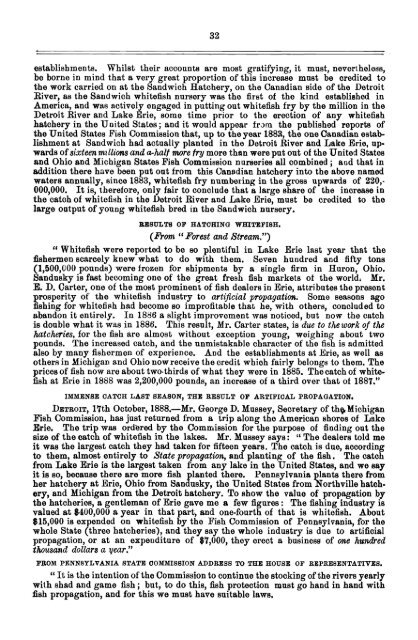Create successful ePaper yourself
Turn your PDF publications into a flip-book with our unique Google optimized e-Paper software.
32<br />
establishments. Whilst their accounts are most gratifying, it must, nevertheless,<br />
be borne in mind that a very great proportion of this increase must be credited to<br />
the work carried on at the Sandwich Hatchery, on the Canadian side of the Detroit<br />
River, as the Sandwich whitefish nursery was the first of the kind established in<br />
America, and was actively engaged in putting out whitefish fry by the million in the<br />
Detroit River and Lake Erie, some time prior to the erection of any whitefish<br />
hatchery in the United States; and it would appear from the published reports of<br />
the United States Fish Commission that, up to the year 1883, the one Canadian estab.<br />
lishment at Sandwich had actually planted in the Detroit River and Lake Erie, upwards<br />
of sixteen millions and a-half more fry more than were put out of the United States<br />
and Ohio and Michigan States Fish Commission nurseries all combined; and that in<br />
addition there have been put out from this Canadian hatchery into the above named<br />
waters annually, since 1883, whitefish fry numbering in the gross upwards of 220,-<br />
000,000. It is, therefore, only fair to conclude that a large share of the increase in<br />
the catch of whitefish in the Detroit River and Lake Erie, must be credited to the<br />
large output of young whitefish bred in the Sandwich nursery.<br />
RESULTS <strong>OF</strong> HATCHING WHITEFISH.<br />
(From "Forest and Stream.")<br />
"Whitefish were reported to be so plentiful in Lake Erie last year that the<br />
fishermen scarcely knew what to do with them. Seven hundred and fifty tons<br />
(1,500,(J0() pounds) were frozen for shipments by a single firm in Huron, Ohio.<br />
Sandusky is fast becoming one of the great fresh fish markets of the world4 Mr.<br />
E. B. Carter, one of the most prominent of fish dealers in Erie, attributes the present<br />
prosperity of the whitefish industry to artificial propagation. Some seasons ago<br />
fishing for whitefish had become so improfitabie that he, with others, concluded to<br />
abandon it entirely. In 1886 a slight improvement was noticed, but now the catch<br />
is double what it was in 1886. This result, Mr. Carter states, is due to the worI of the<br />
hatcheries, for the fish are almost without exception young, weighing about two<br />
pounds. The increased catch, and the unmistakable character of the fish is admitted<br />
also by many fishermen of experience. And the establishments at Erie, as well as<br />
others in Michigan and Ohio now receive the credit which fairly belongs to them. The<br />
prices of fish now are about two-thirds of what they were in 1885. The catch of whitefish<br />
at Erie in 1888 was 2,200,000 pounds, an increase of a third over that of 1887."<br />
IMMENSE CATCH LAST SEASON, THE RESULT <strong>OF</strong> ARTIFICAL PROPAGATION.<br />
DETROIT, 17th October, 1888.—Mr. George B. Mussey, Secretary of th9,Michigan<br />
Fish Commission, has just returned from a trip along the American shores of Lake<br />
Erie. The trip was ordered by the Commission for the purpose of finding out the<br />
size of the catch of whitefish in the lakes. Mr. Mussey says: "The dealers told me<br />
it was the largest catch they had taken for fifteen years. The catch is due, according<br />
to them, almost entirely to State propagation, and planting of the fish. The catch<br />
from Lake Erie is the largest taken from any lake in the United States, and we say<br />
it is so, because there are more fish planted there. Pennsylvania plants there from<br />
her hatchery at Erie, Ohio from Sandusky, the United States from Northville hatch.<br />
ery, and Michigan from the Detroit hatchery. To show the value of propagation by<br />
the hatcheries, a gentleman of Erie gave me a few figures: The fishing industry is<br />
valued at $400,000 a year in that part, and one-fourth of that is whitefish. About<br />
$15,000 is expended on whitefish by the Fish Commission of Pennsylvania, for the<br />
whole State (three hatcheries), and they say the whole industry is due to artificial<br />
propagation, or at an expenditure of $7,000, they erect a business of one hundred<br />
thousand dollars a ?jear."<br />
FROM PENNSYLVANIA STATE COMMISSION ADDRESS TO THE HOUSE <strong>OF</strong> REPRESENTATIVES.<br />
"It is the intention of the Commission to continue the stocking of the rivers yearly<br />
with shad and game fish; but, to do this, fish protection must go hand in hand with<br />
fish propagation, and for this we must have suitable laws.
















